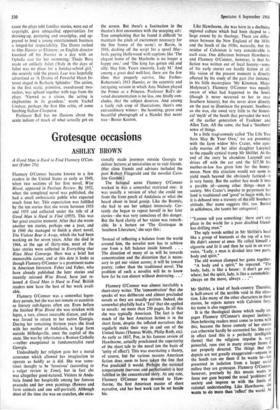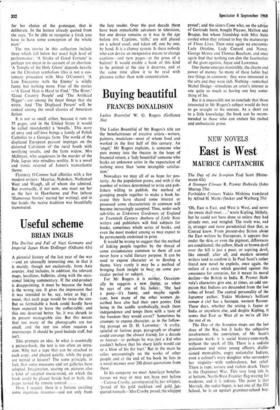Grotesque occasions
ASHLEY BROWN
Flannery O'Connor became known to a few readers in the United States as early as 1949, when two sections of her first novel, Wise Blood, appeared in Partisan Review. By 1952, when the completed novel was published, she had a small enthusiastic public who expected much from her. This expectation was fulfilled by the ten stories that she wrote between 1953 and 1955 and collected under the title of A Good Man is Hard to Find (1955). This was her great creative moment: After that she wrote another ten stories, perhaps one a year, and in 1960 she managed to finish "s short novel, The Violent Bear it Away, which she had been working on for seven years. After she died in 1964, at the age of thirty-nine, most of the later stories were collected in Everything that Rises Must Converge. Hers was a brief but memorable career, and at this date it looks as though Flannery O'Connor is a prominent name in American literature. Faber and Faber, who have already published the later stories and recently reissued Wise Blood, have just re- issued A Good Man is Hard to Find. British readers now have the best of her work avail- able.
Flannery O'Connor was a somewhat legen- dary person, but she was not remote or eccentric as literary cult-figures often are. Even before she finished Wise Blood she was stricken with lupus, a rare, almost incurable disease, and she was forced to return to her native Georgia. During her remaining thirteen years She lived with her mother at Andalusia, a large farm outside Milledgeville, once the capital of the state. She was by inheritance a Roman Catholic —rather exceptional in fundamentalist rural Georgia.
Undoubtedly her religion gave her a moral assurance which allowed her imagination to operate as boldly as it did. She was some- times thought to be 'ferocious' (according to a vulgar review in Time), but in fact she was altogether good-natured. Visitors to Anda- lusia found her hospitable among her famous peacocks and her own paintings (flowers and farm animals and one self-portrait). Although Most of the time she was on crutches, she occa- sionally made journeys outside Georgia to deliver lectures at universities or to visit friends. (Her close friends and advisers included the poet Robea-Fitzgerald and the novelist Caro- line Gordotbi.) The fictional scene Flannery O'Connor worked in Was a somewhat restricted one: it was usually a version of what she could see from -the front porch of Andalusia or what she heard about in local gossip. Like the Brontës, she had to use her subject intensively. Cer- tainly she began to repeat herself in her later stories—she was very conscious of this danger. But the hard clarity of her vision was remark- able. In a lecture on 'The Grotesque in Southern Literature,' she says this: 'Instead of reflecting a balance from the world around him, the novelist now has to achieve one from a felt balance inside himself. . . The direction of many of us will be towards concentration and the distortion that is neces- sary to get our vision across; it will be toward poetry, rather than the traditional novel. The problem of such a novelist will be to know how far he can distort without destroying...
Flannery O'Connor was almost inevitably a short-story writer. The 'concentration' that she speaks of was deliberate and almost precluded novels as they are usually written. Indeed, she somewhat playfully had a 'Test' that she applied to novels: no more than 250 pages. In all this she was typically American. The fact is that much of the best American fiction is in the short form, despite the inflated narratives that regularly make their way in and out of the United States (Thomas Wolfe, Philip Roth, etc). As early as 1837, Poe, in his famous review of Hawthorne, actually proclaimed the superiority of the short tale to the novel (on the basis of 'unity of effect'). This was overstating a theory, of course, but for various reasons American fiction does seem to have taken the line that Poe piedicteif it would. Perhaps the national temperament (nervous and perfectionist) is best fulfilled in the concentrated story. At any rate, Flannery O'Connor was devoted to Haw- thorne, the first American master of short narrative, and her best work can be set beside his. Like Hawthorne, she was born in a declining regional culture which had been shaped to a large extent by its theology. There are differ- ences between the New England of the 1830s and the South of the 1950s, naturally, but the residue of Calvinism is very considerable in each case. One difference between Hawthorne and Flannery O'Connor, however, is that his fiction was written out of local history—some of his early stories are hardly fiction at all. His vision of the present moment is directly affected by his study of the past (for instance, in his little masterpiece 'My Kinsman, Major Molyneux'). Flannery O'Connor was equally aware of what had happened to the South (though it never occurred to her to read Southern history), but she never drew directly on the past to illuminate the present. Southern as she was, she owed very little to the histori- cal 'myth' of the South that pervaded the work of the earlier generation of Faulkner and Allen Tate. All the same, she had a 'Southern' sense of things.
In a little tragi-comedy called 'The Life You Save May Be Your Own,' we are presented with the farm widow Mrs Crater, who cyni- cally marries off her idiot daughter Lucynell to the equally cynical tramp Mr Shiftlet. At the end of the story he abandons Lucynell and drives off with the car and the $17.50 his mother-in-law has given him for the honey- moon. Now this situation would not seem to yield much beyond the obviously farcical—it is very funny. But the author has made it into a parable of—among other things—man in society. Mrs Crater's impulse to perpetuate her land is traditional and 'good' to begin with, but it is debased into a travesty of the old Southern attitude. Her name suggests this, too. Buried in selfishness, she taunts her antagonist "Lemme tell you something: there ain't any place in the world for a poor disabled friend- less drifting man."
The ugly words settled in Mr Shiftlet's bead like a group of blvinrds at the top of a tree. He didn't answer at once. He rolled himself a cigarette and lit it and then he said in an even voice, "Lady, a man is divided into two parts, body and spirit." The old woman clamped her gums together.
"A body and a spirit," he repeated. "The body, lady, is like a house : it don't go any- where; but the spirit, lady, is like a automobile: always on the move, always . . ." ' Mr Shiftlet, a kind of back-country Thersites, is half-aware of the terrible void in this situa- tion. Like many of the other characters in these stories, he rejects nature with Calvinist fury; his name is also suggestive. It is the theological theme which really en- gages Flannery O'Connor's deepest instincts. Non-believing readers must come to terms with this, because the fierce comedy of her stories can otherwise hardly be accounted for. She says in effect (and this is a perfectly intelligible theme) that the religious impulse is very powerful, runs riot in many strange forms if not properly directed. The things that she depicts are not greatly exaggerated—anyone in the South can see them if he wants to—but presented in isolation from a larger social milieu they are grotesque. Flannery O'Connor, however, precisely by this means wants to force our gaze beyond the usual 'problems' of society and impress us with the limits of rational understanding. Like Hawthorne, she wants to do more than 'reflect' the world. As for her choice of the grotesque, that is deliberate. In the lecture already quoted from she says, 'To be able to recognise a freak you have to have some conception of the whole man.'
The ten stories in this collection include three which fall below her usual high level of performance : 'A Stroke of Good Fortune' is perhaps too mean in its account of an abortion. 'A Temple of the Holy Ghost' depends heavily on the Christian symbolism (this is not a cus- tomary procedure with Miss O'Connor). 'A Late Encounter with the Enemy' is wildly funny but nothing more. Four of the stories --`A Good Man is Hard to Find,' The River,' `Good Country People' and 'The Artificial Nigger'—are among the finest things that she wrote. And The Displaced Person' will be ranked among the small classics of American fiction.
It is not so small, either, because it runs to 55 pages, and in the United States it would be called (mistakenly) a 'novella.' This story of envy and self-love brings a family of Polish Catholics to a Georgia farm. The world of the displaced European peasant impinges on the distorted Calvinism of the rural South with terrifying results, and the farm widow, Mrs McIntyre, who acquiesces in the murder of the Pole, lapses into mindless senility. It is a novel and ironic reversal of James's transatlantic theme.
Flannery O'Connor had affinities with a few modern writers: Mauriac, Nabokov, Nathanael West and Waugh, all of whom she admired. But eventually, if not now, one must see her as the heir to Hawthorne and Poe (whose `Humorous Stories' started her writing), and in her hands the native tradition was beautifully transmuted.







































 Previous page
Previous page